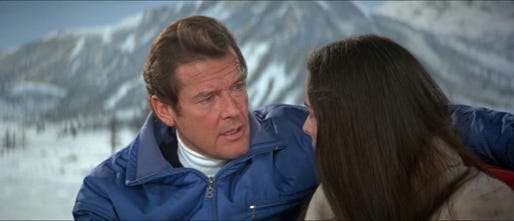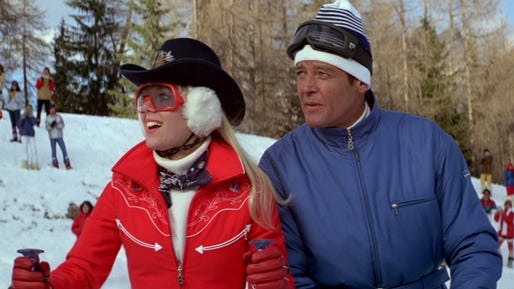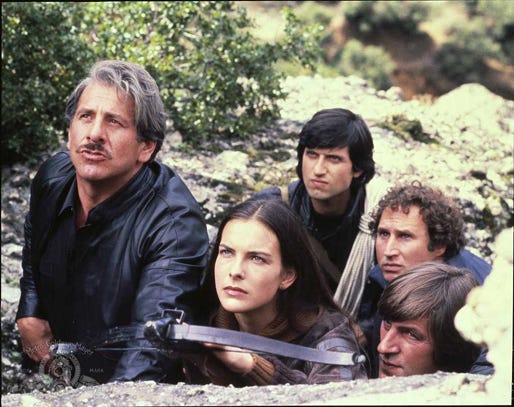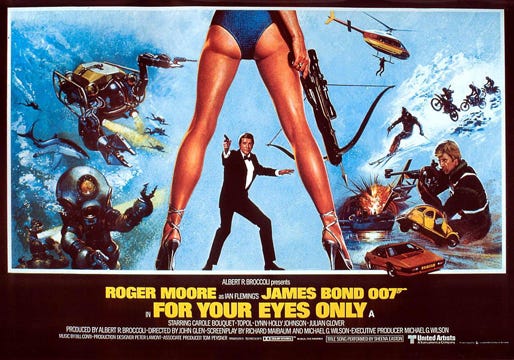You Only Live Twenty-Thrice: "For Your Eyes Only"
“You Only Live Twenty-Thrice” is a look back at the James Bond films.
Each Friday until the release of the 23rd official Bond film, “Skyfall,” we will revisit its 22 official predecessors from start to finish, with a bonus post for the unofficial films in which James Bond also appears.
After visiting outer space, James Bond had nowhere to go but down … and his franchise had nowhere to go but up.
Let’s face it: Bond chasing down a cabal of library-fine scofflaws or tracking stolen Royal Corgis would have carried more urgency than “Moonraker’s” toxic torpor. Scraping together almost any story would have branded 1981’s “For Your Eyes Only” a vast improvement, however slapdash. What an invigorating surprise, then, to see “Eyes” restore some vision to the series, even if it’s at times frustratingly far from 20/20.
The narrative recalls both the action fury of “On Her Majesty’s Secret Service” and the shadow-games subterfuge of “From Russia with Love.” While still globe-trottingly gorgeous, the scenery forgoes grandiosity for grit — no Amazonian grottos, volcanic lairs, underwater strongholds or palatial Kentucky estates, just unforgiving cliffs and coral reefs. Bond also displays something in his sexuality we’ve not yet seen — a limit, as he rebuffs the raunchy advances of a nubile teen skater and offers to buy her an ice cream.
Although still PG-sanitized, the villains’ bloodthirsty barbarism fits their Greek-mob mentality and sticks to the ribs. Moreover, it helps to lift the veil that Roger Moore always so cautiously draped over 007’s more violent tendencies. And director John Glen, who cut his teeth editing and second-unit-directing three previous Bonds, brings it all together well in his directorial debut.
“Eyes” has lingering lows — most egregiously a slight to a fallen cast member. But after “The Spy Who Loved Me,” it’s Moore’s most confident, consistent mission.
You wouldn’t intuit that from the pre-credits sequence — which begins with promise but becomes, especially in hindsight after the film, rather pointless.
Before “Moonraker” was fast-tracked to capitalize on sci-fi fever, “Eyes” was to follow “Spy” — a wise choice given how a certain motif in “Spy” played into the opening shots of “Eyes.”
As Anya goes toe-to-toe with James in “Spy,” she mentions his late wife, Tracy, and draws a chilly, terse response. After again coming to respect a woman of equal fortitude — as Anya was the first he’d found since Tracy — it would make sense to visit his beloved’s grave, as he does in the initial moments of “Eyes.” Bond’s grief is brief, though, when he’s whisked away in a helicopter sent specifically for him.
He thinks he’s been heralded by MI-6. But when the pilot’s brain is zapped and the ’copter starts piloting itself, he realizes he’s again in Blofeld’s clutches.
Oh, wait. Sorry. That wasn’t Blofeld. It was another bald, Nehru jacketed mastermind, wearing a neck brace and stroking a white cat, who had it in for 007.
Although precluded from identifying him as such after Kevin McClory legally maintained rights to SPECTRE and its characters, producer Albert R. “Cubby” Broccoli claimed Blofeld’s dispatch here demonstrated that the series no longer needed his character. Well, duh. Broccoli’s not wrong, but since 1971’s woeful “Diamonds Are Forever,” the series did just fine without even insinuating his involvement.
However, this scene could have been a brilliant way to pick at Bond’s largest scab. Given that “Eyes” revolves around a young woman’s revenge for her parents’ murders, it would seem natural for Bond to seriously address the pain she risks in her pursuit. Yes, he gives her the old “dig two graves for vengeance” bit, but we’d have to wait until “Licence to Kill” to tackle the more interesting question: What psychological pleasure or closure does Bond take in vengeance for his loved ones?
Props to the pilot flying the helicopter so insanely close to the ground that “altitude” barely applies, as well as the stuntman dangling from the skids. But this scene comes nowhere close to the rush of its immediate predecessors and feels mostly like an arrogant shot across McClory’s bow. (Was this the final straw that finally shook free “Never Say Never Again” from development hell to go up against “Octopussy”?)
It leads to an opening-credits sequence that, for the first and only time, features footage of the title-song artist. As written by Bill Conti — who will be justly excoriated in a bit — “For Your Eyes Only” is an aggressively sugary power ballad on which Sheena Easton gives her all for a memorable, if not mighty, melody. And the credits resemble an after-hours experiment at an Olan Mills location — Easton appearing as an inset while mermaid-esque women swim about.
After that, the movie gets down to unexpectedly nasty business, beginning with the disturbing flooding of the St. Georges. This spy boat holds the Automatic Targeting Attack Communicator (ATAC), the system used to coordinate the British Navy’s fleet of nuclear submarines.
After a large, floating mine detonates against its hull, water barrels into the ship, sinking the vessel into the Ionian Sea, with crewmen’s screams getting louder and louder until they abruptly, and unnervingly, cut off.
Minutes later, beautiful young Melina Havelock (Carole Bouquet) sees her parents gunned down by an aerial assassin who strafes their boat. She swears vengeance for their death — ordered because her father was determining the sunken St. Georges’ location for Great Britain. In that regard, she’s not unlike Tilly Masterson of “Goldfinger,” although far handier with a crossbow than Tilly was with her rifle.
Melina’s quest intersects with Bond’s mission, given to him not by M (Bernard Lee) but the Minister of Defence, Sir Frederick Gray (Geoffrey Keen). M’s absence is confined to a throwaway line — a shockingly callous disregard to the memory of Lee, who died of stomach cancer before any of his scenes could be filmed.
“Eyes” also shows poor form by offering no end-credits dedication. It’s almost as if the franchise couldn’t be bothered to let something as pesky as real life intrude on the illusion of entertainment — a decision that’s even more offensive given who turns up in the film’s epilogue.
Gray tasks Bond with locating the St. Georges, recovering the ATAC before it falls into the sinister Soviet hands of General Gogol (Walter Gotell), and determining who bombed the ship in the first place.
It’s considerably easier to finger the culprit who starts trying to sink the movie at that point — Conti, the replacement for John Barry, who was then avoiding the United Kingdom for tax purposes.
Bond eventually tracks the Havelocks’ assassin to Spain. And as 007 prowls the poolside perimeter of the mansion where he’s hiding out, this song plays. It won’t be hard to pay particular attention to the lyrics, written by Bill Conti’s wife, Shelby.
Yes, the producers who once took offense to Lulu suggestively singing “Who will he bang?” unnecessarily drop a stanky sex jam — as depressingly terrible as it is hilariously overt — into the middle of the movie. And as the assassin and his protectors give chase to James, the music conjures images not of assured action but suburban moms donning leggings and leotards to get ready for Jazzercise.
Barry couldn’t tackle them all and he wasn’t without occasional faults, either. But Conti’s work ranks with Eric Serra’s techno-wank in “GoldenEye” as one of the series’ worst. At least the script’s suspense and relative seriousness — compliments of series stalwart Richard Maibaum and Broccoli’s stepson, Michael G. Wilson — tempers Conti’s insistence on cartoonish, Casiotone-disco nonsense.
It’s alleged that Wilson pushed Moore on set to leave his comfort zone as Bond — demonstrated when 007 holds the fate of Emile Leopold Locque, a mute and merciless hitman, in his hands.
Moore’s raffish grin often belied the brutality in Bond’s belly, and he appears to bleed more in “Eyes” than in any other go-round. As Kananga and Scaramanga goaded the Moore Bond’s license to kill, so do the shifty Greek crime bosses with whom Bond becomes entangled.
There’s the gregarious Milos Columbo (Topol, of “Fiddler on the Roof” fame) and the suave Aris Kristatos (Julian Glover, shortlisted to play 007 after Sean Connery left a second time). Each tries to sell out the other for bombing the St. Georges, orchestrating the Havelocks’ murder, and planning to retrieve the ATAC for Gogol. And the back-and-forth in determining which one is the true foe sustains “Eyes” during unnecessary interludes with Bibi (Lynn-Holly Johnson), the horny Olympic-training skater and skiing aficionado happens to be Kristatos’s niece.
Bibi never gets James in bed, but she does get him out on the powder — leading to yet another black-diamond stunner from ski-sequence maestro Willy Bogner. Its see-it-to-believe it quality trumps his already-legendary work in “Service” and “Spy.”
And it’s eventually confirmed that Bibi’s uncle is the true bad guy — attempting to kill Bond and Melina in the St. Georges wreckage nearly 600 feet under the sea and then dragging them, bare-fleshed, along skin-cutting coral.
Aided by Columbo, Bond and Melina survive Kristatos’s sadism to plan a siege on his mountaintop compound — where Gogol is flying to retrieve the ATAC. Yes, yet another seemingly impregnable lair, but Glen changes things up by giving the group a guerrilla nature — a grimy, ragtag batch of Grecian, gun-toting good guys visually on par with “The Dirty Dozen.”
Glen also presides over Rick Sylvester’s latest thrilling stunt — following “Spy” and “Moonraker” with a death-defying dead drop down a fixed line while climbing the mountain’s face. Petrified of heights, Moore drank on set to calm his nerves just for the close-ups. And although visual effects supervisor Derek Meddings devised a system to lessen the drop’s intensity, plans could have easily gone haywire … as in fatal.
It would be best to end “Eyes” atop that mountain when Kristatos meets his end. But alas, the leaden epilogue drags out as impersonators of Margaret and Denis Thatcher call to personally thank 007 … and instead wind up talking to a parrot named Max. That real politicians, cheekishly sent up as they may be, find their way into “Eyes” while it can’t muster even a brief appreciation for Lee is insulting.
There are quite a few individual pieces of “Eyes” that don’t quite fit. But to borrow from its Olympic theme, its gymnastic flexibility sure lets it excel in the all-around.
Next week: "Octopussy"
BULLET POINTS
No James Bond song has ever won an Academy Award for Best Song, and only three were nominated — “Live and Let Die,” “Nobody Does it Better” (from "The Spy Who Loved Me") and “For Your Eyes Only.” Coincidentally, the nomination for “Eyes” was the last for any 007 film.
Another entry in the rejected Bond theme canon: Blondie’s “For Your Eyes Only.” More rugged than Sheena Easton’s ballad, its robust guitar rumble recalls both “The James Bond Theme” and “Atomic.” Still, it can’t shake a tossed-off feeling, and the first couplet (“Don’t look over my shoulder / I’m trying to read”) is a head-scratcher. It was eventually released on 1982’s “The Hunter.”
“For Your Eyes Only” boasts the largest age gap between the actor playing 007and the actress playing the Bond girl — a whopping 29 years separating Roger Moore from Carole Bouquet. (Maybe that’s why they’re never explicitly shown sleeping together.) Amusingly enough, Bouquet was but a year or so older than Lynn Holly-Johnson, whose advances Bond brushes off before offering to buy her ice cream.
The film’s poster alleges to depict Melina Havelock holding a crossbow — from behind, with a backwards bikini bottom exposing her butt cheeks. Print ads in the Boston Globe and the Los Angeles Times edited out everything above her knee, and Pittsburgh Press editors painted a pair of shorts over the offending flesh.
Actor Jack Hedley makes a quick, violent exit when Sir Timothy Havelock is gunned down. But Hedley also voiced Max, the Havelocks’ parrot who proves helpful.







